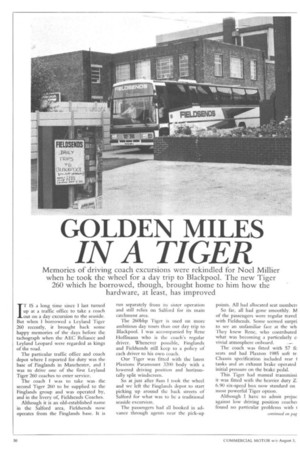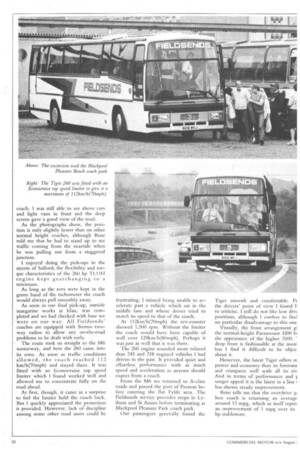GOLDEN MILES
Page 54

Page 56

If you've noticed an error in this article please click here to report it so we can fix it.
IN A TIGER
Memories of driving coach excursions were rekindled for Noel Millier when he took the wheel for a day trip to Blackpool. The new Tiger 260 which he borrowed, though, brought home to him how the hardware, at least, has improved
IT IS a long time since I last turned up at a traffic office to take a coach out on a day excursion to the seaside. But when I borrowed a Leyland Tiger 260 recently, it brought back sonic happy memories of the days before the tachograph when the AEC Reliance and Leyland Leopard were regarded as kings of the road.
The particular traffic office and coach depot where I reported for duty was the base of Finglands in Manchester, and I was to drive one of the first Leyland Tiger 260 coaches to enter service.
The coach 1 was to take was-the second Tiger 260 to be supplied to the Finglands group and was operated by, and in the livery of, Fieldsends Coaches.
Although it is an old-established name in the Salford area, Fieldsends now operates from the Finglands base. It is run separately from its sister operation and still relies on Salford for its main catchment area.
The 260bhp Tiger is used on more ambitious day tours than our day trip to Blackpool. I was accompanied by Rene Hoffmann who is the coach's regular driver. Whenever possible, Finglands and Fieldsends still keep to a policy of each driver to his own coach.
Our Tiger was fitted with the latest Plaxtons Paramount 3200 body with a lowered driving position and horizontally split windscreen.
So at just after 8am I took the wheel and we left the Finglands depot to start picking up around the back streets of Salford for what was to be a traditional seaside excursion.
The passengers had all booked in advance through agents near the pick-up points. All had allocated seat numben So far, all had gone smoothly. M of the passengers were regular travel with Fieldsends. Some seemed surpri to see an unfamiliar face at the whThey knew Rene, who contributed what was becoming a particularly c. vivial atmosphere onboard.
The coach was fitted with 57 fi: seats and had Plaxton 1985 soft tr. Chassis specification included rear tanks and an exhaust brake operated initial pressure on the brake pedal.
This Tiger had manual transmissi it was fitted with the heavier duty Z: 6.90 six-speed box now standard on most powerful Tiger option.
Although 1 have to admit prejuc against low driving position coache!, found no particular problems with coach. I was still able to see above cars and light vans in front and the deep screen gave a good view of the road.
As the photographs show, -the position is only slightly lower than on other normal height coaches, although Rene told me that he had to stand up to see traffic coming from the nearside when he was pulling out from a staggered junction.
I enjoyed doing the pick-ups in the streets of Salford; the flexibility and torque characteristics of the 260 hp TL1111 engine kept gearchanging to a minimum.
As long as the revs were kept in the green band of the tachometer the coach would always pull smoothly away.
As soon as our final pick-up, outside margarine works at Irian, was completed and we had checked with base we were on our way. All Fieldsends' coaches are equipped with Storno two, way radios to allow any on-the-road problems to be dealt with early.
The route took us straight to the MG motorway, and here the 260 came into its own. As soon as traffic conditions allowed, the coach reached 112 • km/h(70mph) and stayed there. It was
• fitted with an Econocruise top speed limiter which I found worked well and allowed me to concentrate fully on the road ahead.
At first, though, it came as a surprise to feel the limiter hold the coach back. But I quickly appreciated the protection it provided. However, lack of discipline among some other road users could be
frustrating; I missed being unable to accelerate past a vehicle which sat in the middle lane and whose driver tried to match its speed to that of the coach.
At 112km/h(70mph) the rev-counter showed 1,500 rpm. Without the limiter the coach would have been capable of well over 129km/h(80mph). Perhaps it was just as well that it was there.
The 260 engine sounded more relaxed than 245 and 218 cngined vehicles I had driven in the past. It provided quiet and effortless performance with as much speed and acceleration as anyone should expect from a coach.
From the M6 we returned to A-class roads and passed the port of Preston before entering the flat Fylde area. The Fieldsends service provides stops in Lytham and St Antics before terminating at Blackpool Pleasure Park coach park.
Our passengers generally found the Tiger smooth and comfortable. Fr the drivers' point of view I found li to criticise. I still do not like low drrv positions, although I confess to find no particular disadvantage to this one
Visually, the front arrangernent gi the normal-height Paramount 3200 bi the appearance of the higher 3500. drop front is fashionable at the MOW. but I find it difficult to be objec about it.
However, the latest Tiger offers m power and economy than its forerunt and compares well with all its riv And in terms of performance and I senger appeal it is the latest in a line I has shown steady improvement.
Rene tells me that die overdrive g. box coach is returning an average around 12 mpg, which in itself repre! an improvement of 1 mpg over its hp stablemate.






















































































